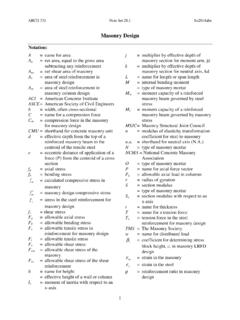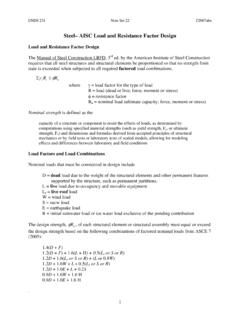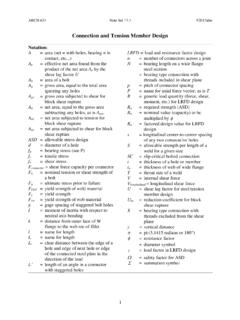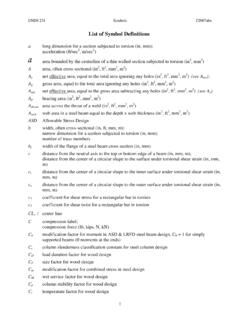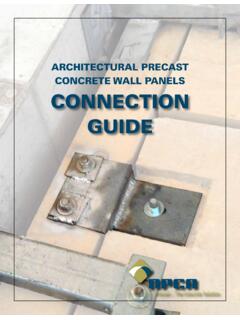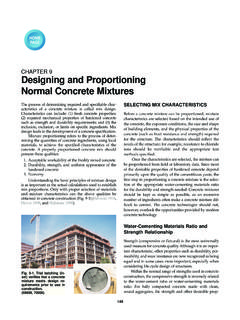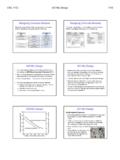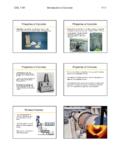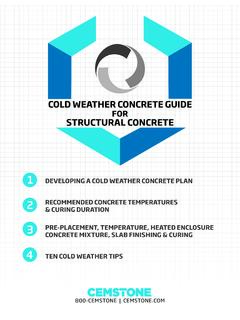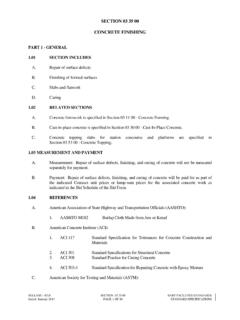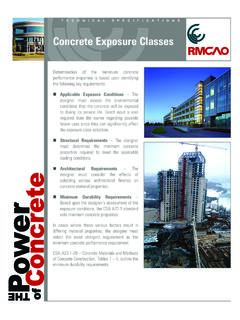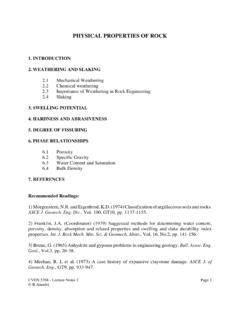Transcription of Reinforced Concrete Design
1 ARCH 331 Note Set Su2014abn Reinforced Concrete Design Notation: a = depth of the effective compression Es = modulus of elasticity of steel block in a Concrete beam f = symbol for stress A = name for area fc = compressive stress Ag = gross area, equal to the total area fc = Concrete Design compressive stress ignoring any reinforcement fpu = tensile strength of the prestressing As = area of steel reinforcement in reinforcement Concrete beam Design fs = stress in the steel reinforcement for As = area of steel compression Concrete Design reinforcement in Concrete beam fs = compressive stress in the Design compression reinforcement for Ast = area of steel reinforcement in Concrete beam Design Concrete column Design fy = yield stress or strength Av = area of Concrete shear stirrup F = shorthand for fluid load reinforcement Fy = yield strength ACI = American Concrete Institute G = relative stiffness of columns to b = width, often cross-sectional beams in a rigid connection, as is.
2 BE = effective width of the flange of a h = cross-section depth Concrete T beam cross section H = shorthand for lateral pressure load bf = width of the flange hf = depth of a flange in a T section bw = width of the stem (web) of a Itransformed = moment of inertia of a multi- Concrete T beam cross section material section transformed to one c = distance from the top to the neutral material axis of a Concrete beam (see x) k = effective length factor for columns cc = shorthand for clear cover b = length of beam in rigid joint C = name for centroid = name for a compression force c = length of column in rigid joint Cc = compressive force in the ld = development length for reinforcing compression steel in a doubly steel Reinforced Concrete beam l dh = development length for hooks Cs = compressive force in the Concrete ln = clear span from face of support to of a doubly Reinforced Concrete face of support in Concrete Design beam L = name for length or span length.
3 As is d = effective depth from the top of a l Reinforced Concrete beam to the = shorthand for live load centroid of the tensile steel Lr = shorthand for live roof load d = effective depth from the top of a LL = shorthand for live load Reinforced Concrete beam to the Mn = nominal flexure strength with the centroid of the compression steel steel reinforcement at the yield db = bar diameter of a reinforcing bar stress and Concrete at the Concrete D = shorthand for dead load Design strength for Reinforced DL = shorthand for dead load Concrete beam Design E = modulus of elasticity or Young's Mu = maximum moment from factored modulus loads for LRFD beam Design = shorthand for earthquake load Ec = modulus of elasticity of Concrete 1. ARCH 331 Note Set Su2014abn n = modulus of elasticity wLL = load per unit length on a beam from transformation coefficient for steel live load to Concrete wself wt = name for distributed load from self = shorthand for neutral axis ( ) weight of member pH = chemical alkalinity wu = load per unit length on a beam from P = name for load or axial force vector load factors Po = maximum axial force with no W = shorthand for wind load concurrent bending moment in a x = horizontal distance Reinforced Concrete column = distance from the top to the neutral Pn = nominal column load capacity in axis of a Concrete beam (see c).
4 Concrete Design y = vertical distance Pu = factored column load calculated 1 = coefficient for determining stress from load factors in Concrete Design block height, a, based on Concrete R = shorthand for rain or ice load strength, fc . Rn = Concrete beam Design ratio = = elastic beam deflection Mu/bd2. = strain s = spacing of stirrups in Reinforced t = strain in the steel Concrete beams y = strain at the yield stress S = shorthand for snow load = resistance factor t = name for thickness T = name for a tension force c = resistance factor for compression = shorthand for thermal load = density or unit weight U = factored Design value = radius of curvature in beam Vc = shear force capacity in Concrete deflection relationships Vs = shear force capacity in steel shear = reinforcement ratio in Concrete stirrups beam Design = As/bd Vu = shear at a distance of d away from the face of support for Reinforced balanced = balanced reinforcement ratio in Concrete beam Design Concrete beam Design wc = unit weight of Concrete c = shear strength in Concrete Design wDL = load per unit length on a beam from dead load Reinforced Concrete Design Structural Design standards for Reinforced Concrete are established by the Building Code and Commentary (ACI 318-11)
5 Published by the American Concrete Institute International, and uses strength Design (also known as limit state Design ). f'c = Concrete compressive Design strength at 28 days (units of psi when used in equations). Materials Concrete is a mixture of cement, coarse aggregate , fine aggregate , and water. The cement hydrates with the water to form a binder. The result is a hardened mass with filler and pores. There are various types of cement for low heat, rapid set, and other properties. Other minerals or cementitious materials (like fly ash) may be added. 2. ARCH 331 Note Set Su2014abn ASTM designations are Type I: Ordinary portland cement (OPC). Type II: Moderate heat of hydration and sulfate resistance Type III: High early strength (rapid hardening). Type IV: Low heat of hydration Type V: Sulfate resistant The proper proportions, by volume, of the mix constituents determine strength, which is related to the water to cement ratio (w/c). It also determines other properties, such as workability of fresh Concrete .
6 Admixtures, such as retardants, accelerators, or superplasticizers, which aid flow without adding more water, may be added. Vibration may also be used to get the mix to flow into forms and fill completely. Slump is the measurement of the height loss from a compacted cone of fresh Concrete . It can be an indicator of the workability. Proper mix Design is necessary for durability. The pH of fresh cement is enough to prevent reinforcing steel from oxidizing (rusting). If, however, cracks allow corrosive elements in water to penetrate to the steel, a corrosion cell will be created, the steel will rust, expand and cause further cracking. Adequate cover of the steel by the Concrete is important. Deformed reinforcing bars come in grades 40, 60 & 75 (for 40 ksi, 60 ksi and 75 ksi yield strengths). Sizes are given as # of 1/8 up to #8 bars. For #9 and larger, the number is a nominal size (while the actual size is larger). Reinforced Concrete is a composite material, and the average density is considered to be 150 lb/ft3.
7 It has the properties that it will creep (deformation with long term load) and shrink (a result of hydration) that must be considered. Construction Because fresh Concrete is a viscous suspension, it is cast or placed and not poured. Formwork must be able to withstand the hydraulic pressure. Vibration may be used to get the mix to flow around reinforcing bars or into tight locations, but excess vibration will cause segregation, honeycombing, and excessive bleed water which will reduce the water available for hydration and the strength, subsequently. After casting, the surface must be worked. Screeding removes the excess from the top of the forms and gets a rough level. Floating is the process of working the aggregate under the surface and to float some paste to the surface. Troweling takes place when the mix has hydrated to the point of supporting weight and the surface is smoothed further and consolidated. Curing is allowing the hydration process to proceed with adequate moisture.
8 Black tarps and curing compounds are commonly used. Finishing is the process of adding a texture, commonly by using a broom, after the Concrete has begun to set. 3. ARCH 331 Note Set Su2014abn Behavior Plane sections of composite materials can still be assumed to be plane (strain is linear), but the stress distribution is not the same in both materials because the modulus of elasticity is different. (f=E ). E1 y E2 y f1 E1 f 2 E2 .. In order to determine the stress, we can define n as the ratio of the elastic moduli: E. n 2. E1. n is used to transform the width of the second material such that it sees the equivalent element stress. Transformed Section y and I. In order to determine stresses in all types of material in the beam, we transform the materials into a single material, and calculate the location of the neutral axis and modulus of inertia for that material. ex: When material 1 above is Concrete and material 2 is steel E2 E. to transform steel into Concrete n steel E1 Econcrete to find the neutral axis of the equivalent Concrete member we transform the width of the steel by multiplying by n to find the moment of inertia of the equivalent Concrete member, I transformed, use the new geometry resulting from transforming the width of the steel My Concrete stress: f Concrete .
9 I transformed Myn steel stress: f steel . I transformed 4. ARCH 331 Note Set Su2014abn Reinforced Concrete Beam Members Strength Design for Beams Sstrength Design method is similar to LRFD. There is a nominal strength that is reduced by a factor which must exceed the factored Design stress. For beams, the Concrete only works in compression over a rectangular stress block above the from elastic calculation, and the steel is exposed and reaches the yield stress, Fy For stress analysis in Reinforced Concrete beams the steel is transformed to Concrete any Concrete in tension is assumed to be cracked and to have no strength the steel can be in tension, and is placed in the bottom of a beam that has positive bending moment 5. ARCH 331 Note Set Su2014abn The neutral axis is where there is no stress and no strain. The Concrete above the is in compression. The Concrete below the is considered ineffective. The steel below the is in tension. Because the is defined by the moment areas, we can solve for x knowing that d is the distance from the top of the Concrete section to the centroid of the steel: x bx nAs ( d x ) 0.
10 2. x can be solved for when the equation is rearranged into the generic format with a, b & c in the b b 2 4ac binomial equation: ax 2 bx c 0 by x . 2a T-sections f f If the is above the bottom of a flange in a T hf hf section, x is found as for a rectangular section. bw If the is below the bottom of a flange in a T. section, x is found by including the flange and the stem of the web (bw) in the moment area calculation: bw h . b f h f x f x h f bw x h f nA (d x) 0. 2 2. s Load Combinations (Alternative values are allowed). + + (Lr or S or R). + (Lr or S or R) + ( or ). + + + (Lr or S or R). + + + + + Internal Equilibrium b 'c C a/2 C. C = compression in Concrete = x a=. stress x area = f cba h d 1x T = tension in steel = As T T. stress x area = Asfy actual stress Whitney stress block 6. ARCH 331 Note Set Su2014abn C = T and Mn = T(d-a/2). where f'c = Concrete compression strength a = height of stress block f c 4000 . 1 = factor based on f'c 1 ( ) x or c = location to the neutral axis 1000.




